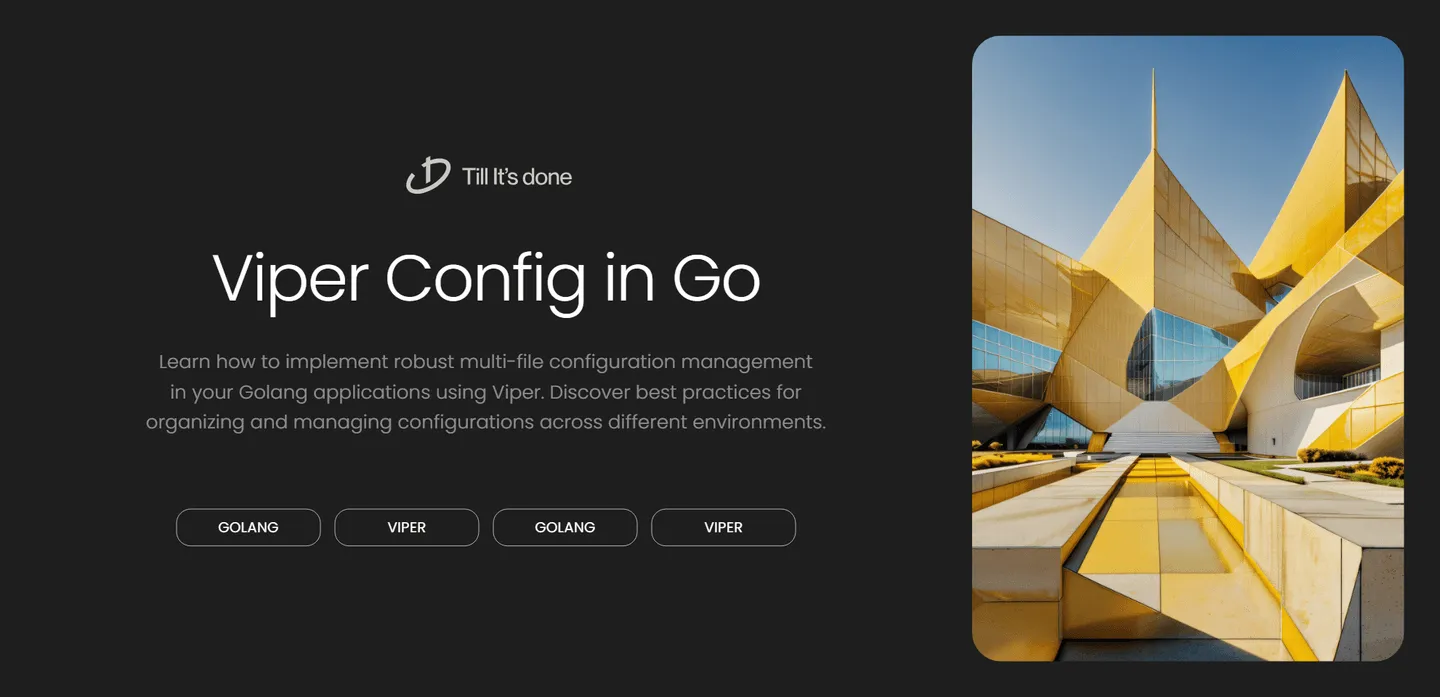- Services
- Case Studies
- Technologies
- NextJs development
- Flutter development
- NodeJs development
- ReactJs development
- About
- Contact
- Tools
- Blogs
- FAQ
Multi-File Config Management with Viper in Go
Discover best practices for organizing and managing configurations across different environments.

Setting Up Multi-File Configuration Management with Viper in Golang

Managing configuration in modern applications can be tricky, especially when dealing with multiple environments and configuration sources. Enter Viper - a complete configuration solution for Go applications that takes the pain out of handling configuration files. Today, let’s explore how to implement a robust multi-file configuration setup using Viper.
Why Multi-File Configuration?
Just like how we organize our codebase into different modules, splitting configuration files makes perfect sense. You might want separate files for database settings, API configurations, and environment-specific overrides. This approach improves maintainability and makes it easier to manage different deployment environments.

Setting Up the Project Structure
Let’s set up a practical project structure that separates our configuration files logically:
project/ ├── config/ │ ├── config.go │ ├── database.yaml │ ├── api.yaml │ └── environment/ │ ├── development.yaml │ └── production.yaml ├── go.mod └── main.goImplementing the Configuration Manager
Our configuration manager needs to handle multiple YAML files and merge them appropriately. Here’s how we can implement this:
package config
import ( "fmt" "github.com/spf13/viper")
type Config struct { Database DatabaseConfig API APIConfig Environment string}
type DatabaseConfig struct { Host string Port int Username string Password string}
type APIConfig struct { Port int Timeout int Version string}
func LoadConfig(env string) (*Config, error) { v := viper.New()
// Load base configurations v.SetConfigType("yaml") v.AddConfigPath("./config")
// Load and merge database config v.SetConfigName("database") if err := v.MergeInConfig(); err != nil { return nil, fmt.Errorf("error loading database config: %w", err) }
// Load and merge API config v.SetConfigName("api") if err := v.MergeInConfig(); err != nil { return nil, fmt.Errorf("error loading api config: %w", err) }
// Load environment-specific config v.AddConfigPath(fmt.Sprintf("./config/environment")) v.SetConfigName(env) if err := v.MergeInConfig(); err != nil { return nil, fmt.Errorf("error loading environment config: %w", err) }
var config Config if err := v.Unmarshal(&config); err != nil { return nil, fmt.Errorf("unable to decode config into struct: %w", err) }
return &config, nil}
Using the Configuration in Your Application
Now that we have our configuration manager set up, using it in your application is straightforward:
func main() { config, err := config.LoadConfig("development") if err != nil { log.Fatalf("Error loading config: %v", err) }
fmt.Printf("Database Host: %s\n", config.Database.Host) fmt.Printf("API Version: %s\n", config.API.Version)}The beauty of this setup is that you can easily override specific settings for different environments while maintaining a clear, organized structure. Environment-specific configurations will automatically merge with and override the base settings, giving you complete control over your application’s behavior in different deployment scenarios.
Best Practices
- Always validate configuration values after loading
- Use environment variables for sensitive information
- Keep configuration files as simple as possible
- Document all configuration options
- Use strong typing for configuration structs
By following these patterns, you’ll have a maintainable and scalable configuration system that can grow with your application.

 สร้างเว็บไซต์ 1 เว็บ ต้องใช้งบเท่าไหร่? เจาะลึกทุกองค์ประกอบ website development cost อยากสร้างเว็บไซต์แต่ไม่มั่นใจในเรื่องของงบประมาณ อ่านสรุปเจาะลึกตั้งแต่ดีไซน์, ฟังก์ชัน และการดูแล พร้อมตัวอย่างงบจริงจาก Till it’s done ที่แผนชัด งบไม่บานปลายแน่นอน
สร้างเว็บไซต์ 1 เว็บ ต้องใช้งบเท่าไหร่? เจาะลึกทุกองค์ประกอบ website development cost อยากสร้างเว็บไซต์แต่ไม่มั่นใจในเรื่องของงบประมาณ อ่านสรุปเจาะลึกตั้งแต่ดีไซน์, ฟังก์ชัน และการดูแล พร้อมตัวอย่างงบจริงจาก Till it’s done ที่แผนชัด งบไม่บานปลายแน่นอน  Next.js สอน 14 ขั้นตอนเบื้องต้น: สร้างโปรเจกต์แรกใน 30 นาที เริ่มต้นกับ Next.js ใน 14 ขั้นตอนเพียงแค่ 30 นาที พร้อม SSR/SSG และ API Routes ด้วยตัวอย่างโค้ดง่าย ๆ อ่านต่อเพื่อสร้างโปรเจ็กต์แรกได้ทันทีที่นี่
Next.js สอน 14 ขั้นตอนเบื้องต้น: สร้างโปรเจกต์แรกใน 30 นาที เริ่มต้นกับ Next.js ใน 14 ขั้นตอนเพียงแค่ 30 นาที พร้อม SSR/SSG และ API Routes ด้วยตัวอย่างโค้ดง่าย ๆ อ่านต่อเพื่อสร้างโปรเจ็กต์แรกได้ทันทีที่นี่  วิธีสมัคร Apple Developer Account เพื่อนำแอปขึ้น App Store ทีละขั้นตอน อยากปล่อยแอปบน App Store ระดับโลก มาอ่านคู่มือสมัคร Apple Developer Account พร้อมเคล็ดลับ TestFlight และวิธีอัปโหลดที่ง่ายในบทความเดียวนี้ได้เลย
วิธีสมัคร Apple Developer Account เพื่อนำแอปขึ้น App Store ทีละขั้นตอน อยากปล่อยแอปบน App Store ระดับโลก มาอ่านคู่มือสมัคร Apple Developer Account พร้อมเคล็ดลับ TestFlight และวิธีอัปโหลดที่ง่ายในบทความเดียวนี้ได้เลย  TypeScript Interface คืออะไร? อธิบายพร้อมวิธีใช้และข้อแตกต่างจาก Type เรียนรู้วิธีใช้ TypeScript Interface เพื่อสร้างโครงสร้างข้อมูลที่ปลอดภัยและเข้าใจง่าย พร้อมเปรียบเทียบข้อดีข้อแตกต่างกับ Type ที่คุณต้องรู้ ถูกรวมเอาไว้ในบทความนี้แล้ว
TypeScript Interface คืออะไร? อธิบายพร้อมวิธีใช้และข้อแตกต่างจาก Type เรียนรู้วิธีใช้ TypeScript Interface เพื่อสร้างโครงสร้างข้อมูลที่ปลอดภัยและเข้าใจง่าย พร้อมเปรียบเทียบข้อดีข้อแตกต่างกับ Type ที่คุณต้องรู้ ถูกรวมเอาไว้ในบทความนี้แล้ว  Material-UI (MUI) คืออะไร อยากสร้าง UI สวยงามและเป็นมืออาชีพในเวลาอันรวดเร็วใช่ไหม มาทำความรู้จักกับ Material-UI (MUI) ที่ช่วยให้คุณพัฒนาแอปพลิเคชันบน React ได้ง่ายและดูดีในทุกอุปกรณ์
Material-UI (MUI) คืออะไร อยากสร้าง UI สวยงามและเป็นมืออาชีพในเวลาอันรวดเร็วใช่ไหม มาทำความรู้จักกับ Material-UI (MUI) ที่ช่วยให้คุณพัฒนาแอปพลิเคชันบน React ได้ง่ายและดูดีในทุกอุปกรณ์  เปรียบเทียบ 3 วิธีติดตั้ง install node js บน Ubuntu: NVM vs NodeSource vs Official Repo แบบไหนดีที่สุด? เรียนรู้วิธีติดตั้ง Node.js บน Ubuntu ด้วย NVM, NodeSource หรือ Official Repo เลือกวิธีที่เหมาะกับความต้องการของคุณ พร้อมเปรียบเทียบ เพื่อการพัฒนาที่มีประสิทธิภาพ!
เปรียบเทียบ 3 วิธีติดตั้ง install node js บน Ubuntu: NVM vs NodeSource vs Official Repo แบบไหนดีที่สุด? เรียนรู้วิธีติดตั้ง Node.js บน Ubuntu ด้วย NVM, NodeSource หรือ Official Repo เลือกวิธีที่เหมาะกับความต้องการของคุณ พร้อมเปรียบเทียบ เพื่อการพัฒนาที่มีประสิทธิภาพ! Talk with CEO
We'll be right here with you every step of the way.
We'll be here, prepared to commence this promising collaboration.
Whether you're curious about features, warranties, or shopping policies, we provide comprehensive answers to assist you.


